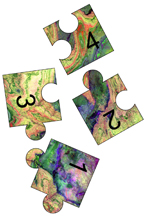How to Use Jigsaws
Initial Publication Date: March 24, 2009
Jump down to Group task | Student preparation | Student accountability | Steps for designing a jigsaw
A good jigsaw topic has a number of hallmarks
- A good topic has team assignments that are related. If team assignments are not related, the peer teaching component becomes nothing more than a series of unrelated mini-presentations.
- A good topic has team assignments that students can complete successfully. This sounds silly, but it isn't. A team assignment that only some students will "get" without significant help is not a good one for jigsaw, because it will be difficult for students to be well-prepared for peer teaching. This doesn't mean that the assignment has to be trivial or easy. It might, in fact, involve significant work and thought. But you have do be confident that most students will "get it", or you should pick a different topic.
- A good topic for a jigsaw is one that doesn't required students to know each team assignment equally well. In a jigsaw, individuals know their own assignments better than any of the ones presented by their peers. This is true partly because students must know their own assignments well enough to explain them and partly because their peers are typically not skilled presenters. This is an unavoidable aspect of the jigsaw technique. If you are considering a topic, and you realize that each student must know all aspects of the topic equally well, choose a teaching strategy other than jigsaw.
An effective group task is crucial for a jigsaw
- Include a group task that follows the peer teaching. Without a group task that requires analysis and synthesis to put the whole picture together, the activity is simply not a jigsaw. More importantly, though, without the requirement to be intellectually engaged in solving a group problem, students have little incentive to learn anything from one another during the peer teaching session. And solving a problem as a group is more intellectually engaging than just having to learn what the other group members know.
- Design the group task to go beyond simply summarizing the team assignments or having each person learn all the team assignments. A group task that merely summarizes the individual presentations is akin to describing each individual piece in a puzzle without putting the pieces together into a picture. A group task that involves analysis or synthesis using components from all of the teams provides the kind of group goal that promotes learning.
Students must be well prepared for the peer teaching component
- Formalize the preparation. Making a vague assignment to "prepare to teach someone about this topic" is rarely adequate. Requiring students to prepare something in writing, even if the team preparation happens in class, can be very helpful both for them and for you. This might include answering a set of guiding questions, writing down observations and interpretations, annotating graphs or figures, and so on.
- Make sure that students are actually prepared. You must make certain that what students will teach is not wrong-headed. If students are preparing something in writing during their team time (see above), you can circulate and read what they have written as they are working. You can also stop at each team and ask students to summarize their thoughts. After you've done a particular jigsaw more than once, you will discover the places where students will likely go astray, and you can home in on those aspects. Collecting and grading written preparation and having the peer teaching/group task portion during a subsequent class is also a possibility, although the immediacy of engaging the topic is lost.
- Give students guidance in how to prepare for peer teaching. Students commonly do not prepare for teaching the way a faculty member does. When asked to teach others about the team's topic, students are very likely to read off the answers to the guiding questions you have asked ("the answer to question one is....."). Students have little practice in stepping away from a topic and asking what the big take-home messages are and how they might frame their teaching around those ideas. Having each team member fill out a peer teaching prep sheet (Acrobat (PDF) 60kB Feb22 09) can reap big dividends during peer teaching. For a jigsaw where students prepare outside of class, having students fill out the teaching prep sheets in teams at the start of class allows teams to talk about how to teach the topic well, gives team members a chance to clear up difficulties, and gives you some time to circulate and check on individual preparation before dividing the class into mixed groups.
Students learn more if they are held individually accountable
- Incorporate a mechanism for individual follow-up. It's harder for students to "skate" in a jigsaw than in many other types of group activities, because students are individually responsible for peer teaching. Students will be more actively engaged in the group task, however, and will learn more as a result, if they know that they will have to do individual follow-ups based on the group task. Follow-ups might range from simple bulleted lists to incorporation of the results of the group task into a major semester synthesis assignment.
- Remember that students will know their own team assignments the best. Take this into account by designing follow-ups that do not require students to know all of the team assignments equally well.
- Consider rewarding the group for the quality of individual performance. Some research work (Slavin, 1996) suggests that rewarding the group when all members perform well on individual follow-up tasks/assignments improves the overall achievement of individuals in a jigsaw setting. Even though students receive individual grades on their follow-up synthesis assignments, choosing a mechanism to also reward the group (e.g., via bonus points) can have benefits in terms of overall learning.




